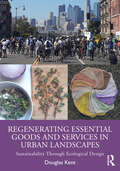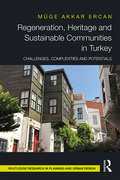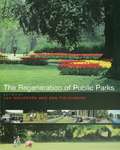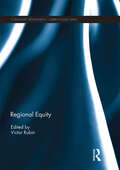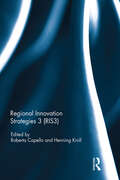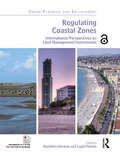- Table View
- List View
Rediscovery of Cultural Landscapes in Southern China: Sustainable Heritage and Planning in Rural Settlements (Planning, Heritage and Sustainability)
by Wallace P.H. ChangThis book investigates the concept of human landscape in rural settlements in Southern China, where communities and their cultural landscapes are facing contemporary challenges following a period of rapid urbanization in the last 50 years. While metropolitan cities, such as Hong Kong, are experiencing accelerated urban development, underpopulated rural villages are struggling to maintain the cultural heritage of their regions. Rediscovery of Cultural Landscapes in Southern China provides a detailed account into indigenous living cultures in traditional, rural settlements upon natural landscapes. Beginning with an overview of the theoretical framework, the book presents six unique cases, including: Tai O, Yim Tin Tsai, Lai Chi Wo, Nga Tsin Wai, Cangdong, and Meinong, while illustrating a relevant comparison between Hakka and Satoyama landscape systems. The spectrum of theoretical and case analyses allows for a rethinking of the evolving cultural landscape’s positioning with valuable heritages in the context of a post-industrial society. The book is written towards reinterpreting the cultural landscape by conceptualizing the human landscape for scholars, practitioners, and students interested in rural-cultural conservation and revitalization, heritage management, traditional architecture and landscape planning, and urban-rural development.
Rediscovery of Cultural Landscapes in Southern China: Sustainable Heritage and Planning in Rural Settlements (Planning, Heritage and Sustainability)
by Wallace P.H. ChangThis book investigates the concept of human landscape in rural settlements in Southern China, where communities and their cultural landscapes are facing contemporary challenges following a period of rapid urbanization in the last 50 years. While metropolitan cities, such as Hong Kong, are experiencing accelerated urban development, underpopulated rural villages are struggling to maintain the cultural heritage of their regions. Rediscovery of Cultural Landscapes in Southern China provides a detailed account into indigenous living cultures in traditional, rural settlements upon natural landscapes. Beginning with an overview of the theoretical framework, the book presents six unique cases, including: Tai O, Yim Tin Tsai, Lai Chi Wo, Nga Tsin Wai, Cangdong, and Meinong, while illustrating a relevant comparison between Hakka and Satoyama landscape systems. The spectrum of theoretical and case analyses allows for a rethinking of the evolving cultural landscape’s positioning with valuable heritages in the context of a post-industrial society. The book is written towards reinterpreting the cultural landscape by conceptualizing the human landscape for scholars, practitioners, and students interested in rural-cultural conservation and revitalization, heritage management, traditional architecture and landscape planning, and urban-rural development.
Regenerating Essential Goods and Services in Urban Landscapes: Sustainability Through Ecological Design
by Douglas KentHow do we provide for and nurture millions of people without destroying the planet in the process? Author Doug Kent, an environmental specialist, believes a vital element in the solution is recognizing that urban landscapes are an essential partner in everyone’s wellbeing. He argues that urban landscapes can and must work harder.Urban landscapes can provide part of our energy needs, help cool our buildings and public spaces, help us make the most of our precious water. They can also help combat air pollution and reduce the likelihood of allergies and asthma. They can provide landscape materials and even contribute to our timber supply. Doug also advocates turning landscapes into a food source, and/or a perfumery, pharmacy, soap shop, or craft store.Doug has over 12 years of research in this book. He has spent years doing literature reviews, and many more years concocting, consuming, crafting, distilling, propagating, retting, sawing, sowing, and weaving its many recommendations. He has also travelled the length and width of California many times to interview the people and businesses already doing this incredible work.Regenerating Essential Goods and Services is not a manifesto. It is a user’s manual. You are the creative and energetic force that will ultimately drive sustainability and regeneration. Let’s go.
Regenerating Essential Goods and Services in Urban Landscapes: Sustainability Through Ecological Design
by Douglas KentHow do we provide for and nurture millions of people without destroying the planet in the process? Author Doug Kent, an environmental specialist, believes a vital element in the solution is recognizing that urban landscapes are an essential partner in everyone’s wellbeing. He argues that urban landscapes can and must work harder.Urban landscapes can provide part of our energy needs, help cool our buildings and public spaces, help us make the most of our precious water. They can also help combat air pollution and reduce the likelihood of allergies and asthma. They can provide landscape materials and even contribute to our timber supply. Doug also advocates turning landscapes into a food source, and/or a perfumery, pharmacy, soap shop, or craft store.Doug has over 12 years of research in this book. He has spent years doing literature reviews, and many more years concocting, consuming, crafting, distilling, propagating, retting, sawing, sowing, and weaving its many recommendations. He has also travelled the length and width of California many times to interview the people and businesses already doing this incredible work.Regenerating Essential Goods and Services is not a manifesto. It is a user’s manual. You are the creative and energetic force that will ultimately drive sustainability and regeneration. Let’s go.
Regenerating London: Governance, Sustainability and Community in a Global City
by Rob Imrie Loretta Lees Mike RacoRegenerating London explores latest thinking on urban regeneration in one of the fastest changing world cities. Engaging with social, economic, and political structures of cities, it highlights paradoxes and contradictions in urban policy and offers an evaluation of the contemporary forms of urban redevelopment.
Regenerating London: Governance, Sustainability and Community in a Global City
by Rob Imrie Loretta Lees Mike RacoRegenerating London explores latest thinking on urban regeneration in one of the fastest changing world cities. Engaging with social, economic, and political structures of cities, it highlights paradoxes and contradictions in urban policy and offers an evaluation of the contemporary forms of urban redevelopment.
Regeneration, Heritage and Sustainable Communities in Turkey: Challenges, Complexities and Potentials
by Muge Akkar ErcanOver the last three decades, historic housing areas have become one of the major concerns in urban regeneration, housing renovation and conservation projects. Since the late 1990s, the notion of community, sustainability and sustainable community have become rising issues in the urban regeneration debate. Regeneration, Heritage and Sustainable Communities in Turkey contributes to this debate by integrating the interplay between regeneration, community needs and sustainability in the context of Istanbul. Together with the relational, multi-scalar and contingency planning approaches, these vital agents of regeneration provide new possibilities and creative opportunities to successfully deal with the uncertainties and complexities in evolving regeneration spaces. The interdisciplinary text reasons that finding the balance between the needs, aspirations and concerns of local communities and the conservation of the built environments will lead to more equitable and sustainable solutions to the problems faced in Istanbul’s historic quarters.
Regeneration, Heritage and Sustainable Communities in Turkey: Challenges, Complexities and Potentials
by Muge Akkar ErcanOver the last three decades, historic housing areas have become one of the major concerns in urban regeneration, housing renovation and conservation projects. Since the late 1990s, the notion of community, sustainability and sustainable community have become rising issues in the urban regeneration debate. Regeneration, Heritage and Sustainable Communities in Turkey contributes to this debate by integrating the interplay between regeneration, community needs and sustainability in the context of Istanbul. Together with the relational, multi-scalar and contingency planning approaches, these vital agents of regeneration provide new possibilities and creative opportunities to successfully deal with the uncertainties and complexities in evolving regeneration spaces. The interdisciplinary text reasons that finding the balance between the needs, aspirations and concerns of local communities and the conservation of the built environments will lead to more equitable and sustainable solutions to the problems faced in Istanbul’s historic quarters.
The Regeneration of Public Parks
by Ken Fieldhouse Jan WoudstraThe Urban Parks Programme, financed by the Heritage Lottery Fund, has sparked a new enthusiasm for the regeneration of Britain's parks. This unique reference book gives a valuable overview of all the elements of public park design. It emphasizes our parks' diversity and richness, and offers practical guidance as to their renovation and future care. It is essential reading for all those involved in the design, upkeep and regeneration of public parks.
The Regeneration of Public Parks
by Jan Woudstra Ken FieldhouseThe Urban Parks Programme, financed by the Heritage Lottery Fund, has sparked a new enthusiasm for the regeneration of Britain's parks. This unique reference book gives a valuable overview of all the elements of public park design. It emphasizes our parks' diversity and richness, and offers practical guidance as to their renovation and future care. It is essential reading for all those involved in the design, upkeep and regeneration of public parks.
Regent Park Redux: Reinventing Public Housing in Canada (RTPI Library Series)
by Laura Johnson Robert JohnsonRegent Park Redux evaluates one of the biggest experiments in public housing redevelopment from the tenant perspective. Built in the 1940s, Toronto’s Regent Park has experienced common large-scale public housing problems. Instead of simply tearing down old buildings and scattering inhabitants, the city’s housing authority came up with a plan for radical transformation. In partnership with a private developer, the Toronto Community Housing Corporation organized a twenty-year, billion-dollar makeover. The reconstituted neighbourhood, one of the most diverse in the world, will offer a new mix of amenities and social services intended to "reknit the urban fabric." Regent Park Redux, based on a ten-year study of 52 households as they moved through stages of displacement and resettlement, examines the dreams and hopes residents have for their community and their future. Urban planners and designers across the world, in cities facing some of the same challenges as Toronto, will want to pay attention to this story.
Regent Park Redux: Reinventing Public Housing in Canada (RTPI Library Series)
by Laura Johnson Robert JohnsonRegent Park Redux evaluates one of the biggest experiments in public housing redevelopment from the tenant perspective. Built in the 1940s, Toronto’s Regent Park has experienced common large-scale public housing problems. Instead of simply tearing down old buildings and scattering inhabitants, the city’s housing authority came up with a plan for radical transformation. In partnership with a private developer, the Toronto Community Housing Corporation organized a twenty-year, billion-dollar makeover. The reconstituted neighbourhood, one of the most diverse in the world, will offer a new mix of amenities and social services intended to "reknit the urban fabric." Regent Park Redux, based on a ten-year study of 52 households as they moved through stages of displacement and resettlement, examines the dreams and hopes residents have for their community and their future. Urban planners and designers across the world, in cities facing some of the same challenges as Toronto, will want to pay attention to this story.
Regional Equity (Community Development – Current Issues Series)
by Victor RubinRegional equity as a field of scholarship, as an arena of policy change, and as a social movement has grown, diversified, and matured in important ways over the past decade. The fruits of that growth and development can be seen in recent federal and state policies, in the practices of many regional planning organizations, and in the agendas and approaches of countless community-based organizations and issue advocacy groups.As the field has expanded, a growing number of researchers have been tracking these phenomena: explaining how and why concepts of metropolitan development are being reframed; documenting the efforts to shape policies and diversify leadership; assessing where and how equity and social justice concerns have been brought into regional planning for transportation, land use, housing, public finances, environmental quality, smart growth, sustainable development, public health and other issue areas. This volume brings together analyses and commentary by some of the leading scholarly observers these timely developments.This book was published as a special issue of Community Development.
Regional Equity (Community Development – Current Issues Series)
by Victor RubinRegional equity as a field of scholarship, as an arena of policy change, and as a social movement has grown, diversified, and matured in important ways over the past decade. The fruits of that growth and development can be seen in recent federal and state policies, in the practices of many regional planning organizations, and in the agendas and approaches of countless community-based organizations and issue advocacy groups.As the field has expanded, a growing number of researchers have been tracking these phenomena: explaining how and why concepts of metropolitan development are being reframed; documenting the efforts to shape policies and diversify leadership; assessing where and how equity and social justice concerns have been brought into regional planning for transportation, land use, housing, public finances, environmental quality, smart growth, sustainable development, public health and other issue areas. This volume brings together analyses and commentary by some of the leading scholarly observers these timely developments.This book was published as a special issue of Community Development.
Regional Innovation Strategies 3 (RIS3)
by Roberta Capello Henning KrollWith regions and nations having formally fulfilled the ex ante conditionality, this book provides a first overall review of RIS3 policy processes, aiming to assess the consistency of the concept of smart specialization from an applied, policy-oriented perspective. Moving from the theory of design to the practice of implementation, the reflections and case studies in this volume reveal strengths and weaknesses in the way concrete strategies have been conceived and implemented, enabling reflections on the future of the concept in a more general sense. In many cases, smart specialization strategies turn out to be new variants of regional development policies, embracing the importance of a place-based approach. However, the approach’s potential to add distinctive value will stem from its capacity to turn innovation and knowledge into tools for local development by harnessing them for wider territorial development goals. By helping regions to identify and leverage untapped resources through new processes, smart specialization-based policies may help to reconcile cohesion and competitiveness objective. Consequently, new approaches appear most promising where institutional, administrative and political conditions allow the setup of genuinely new processes and where their focus is on territorial assets in a comprehensive manner rather than mere industrial renewal. This book was originally published as a special issue of European Planning Studies.
Regional Innovation Strategies 3 (RIS3)
by Roberta Capello Henning KrollWith regions and nations having formally fulfilled the ex ante conditionality, this book provides a first overall review of RIS3 policy processes, aiming to assess the consistency of the concept of smart specialization from an applied, policy-oriented perspective. Moving from the theory of design to the practice of implementation, the reflections and case studies in this volume reveal strengths and weaknesses in the way concrete strategies have been conceived and implemented, enabling reflections on the future of the concept in a more general sense. In many cases, smart specialization strategies turn out to be new variants of regional development policies, embracing the importance of a place-based approach. However, the approach’s potential to add distinctive value will stem from its capacity to turn innovation and knowledge into tools for local development by harnessing them for wider territorial development goals. By helping regions to identify and leverage untapped resources through new processes, smart specialization-based policies may help to reconcile cohesion and competitiveness objective. Consequently, new approaches appear most promising where institutional, administrative and political conditions allow the setup of genuinely new processes and where their focus is on territorial assets in a comprehensive manner rather than mere industrial renewal. This book was originally published as a special issue of European Planning Studies.
Regional Innovation Systems: The Role of Governances in a Globalized World
by Philip Cooke Martin Heidenreich Hans-Joachim BraczykSince the first edition of this book in 1995, there has been a worldwide innovation-led economic boom and a subsequent slump, meaning enormous change has also occurred at the level of regional economies. The new edition registers this change and provides an interesting test of the robustness of the original arguments in the book. Not least, more industrial policy making is influenced by the RIS analysis, and many national and regional governments have adopted RIS approaches, along with related instruments like promotion of industry clusters, academic entrepreneurship, regional venture capital and science-led development strategies.
Regional Innovation Systems: The Role of Governances in a Globalized World
Since the first edition of this book in 1995, there has been a worldwide innovation-led economic boom and a subsequent slump, meaning enormous change has also occurred at the level of regional economies. The new edition registers this change and provides an interesting test of the robustness of the original arguments in the book. Not least, more industrial policy making is influenced by the RIS analysis, and many national and regional governments have adopted RIS approaches, along with related instruments like promotion of industry clusters, academic entrepreneurship, regional venture capital and science-led development strategies.
Regional Planning: Concepts, Theory And Practice (Natural and Built Environment Series)
by John Glasson Tim MarshallRegional Planning provides a comprehensive introduction to the concepts and theory of regional planning in the UK. Drawing on examples from throughout the UK, it provides students and practitioners with a descriptive and analytical foundation for understanding this rapidly changing area of planning. The book includes four main sections covering: the context and history of regional planning theoretical approaches evolving practice future prospects. New questions and methods of theorizing are explored and new connections made with contemporary debates in geography, political science and planning theory. The elements of critical analysis allow both practitioners and more advanced students to reflect upon their activities in a contemporary context. Regional Planning is the essential, up-to-date text for students interested in all aspects of this increasingly influential subject.
Regions and Designed Landscapes in Georgian England (Routledge Research in Landscape and Environmental Design)
by Sarah SpoonerGarden design evolved hugely during the Georgian period – as symbols of wealth and stature, the landed aristocracy had been using gardens for decades. Yet during the eighteenth century, society began to homogenise, and the urban elite also started demanding landscapes that would reflect their positions. The gardens of the aristocracy and the gentry were different in appearance, use and meaning, despite broad similarities in form. Underlying this was the importance of place, of the landscape itself and its raw material. Contemporaries often referred to the need to consult the ‘genius of the place’ when creating a new designed landscape, as the place where the garden was located was critical in determining its appearance. Genius loci - soil type, topography, water supply - all influenced landscape design in this period. The approach taken in this book blends landscape and garden history to make new insights into landscape and design in the eighteenth century. Spooner’s own research presents little-known sites alongside those which are more well known, and explores the complexity of the story of landscape design in the Georgian period which is usually oversimplified and reduced to the story of a few ‘great men’.
Regions and Designed Landscapes in Georgian England (Routledge Research in Landscape and Environmental Design)
by Sarah SpoonerGarden design evolved hugely during the Georgian period – as symbols of wealth and stature, the landed aristocracy had been using gardens for decades. Yet during the eighteenth century, society began to homogenise, and the urban elite also started demanding landscapes that would reflect their positions. The gardens of the aristocracy and the gentry were different in appearance, use and meaning, despite broad similarities in form. Underlying this was the importance of place, of the landscape itself and its raw material. Contemporaries often referred to the need to consult the ‘genius of the place’ when creating a new designed landscape, as the place where the garden was located was critical in determining its appearance. Genius loci - soil type, topography, water supply - all influenced landscape design in this period. The approach taken in this book blends landscape and garden history to make new insights into landscape and design in the eighteenth century. Spooner’s own research presents little-known sites alongside those which are more well known, and explores the complexity of the story of landscape design in the Georgian period which is usually oversimplified and reduced to the story of a few ‘great men’.
Regulating Coastal Zones: International Perspectives on Land Management Instruments (Urban Planning and Environment)
by Rachelle Alterman Cygal PellachRegulating Coastal Zones addresses the knowledge gap concerning the legal and regulatory challenges of managing land in coastal zones across a broad range of political and socio-economic contexts. In recent years, coastal zone management has gained increasing attention from environmentalists, land use planners, and decision-makers across a broad spectrum of fields. Development pressures along coasts such as high-end tourism projects, luxury housing, ports, energy generation, military outposts, heavy industry, and large-scale enterprise compete with landscape preservation and threaten local history and culture. Leading experts present fifteen case studies among advanced-economy countries, selected to represent three groups of legal contexts: signatories to the 2008 Mediterranean ICZM Protocol, parties to the 2002 EU Recommendation on Integrated Coastal Zone Management, and the USA and Australia. This book is the first to address the legal-regulatory aspects of coastal land management from a systematic cross-national comparative perspective. By including both successful and less-effective strategies, it aims to inform professionals, graduate students, policy makers, and NGOs of the legal and socio-political challenges as well as the better practices from which others could learn.
Regulating Coastal Zones: International Perspectives on Land Management Instruments (Urban Planning and Environment)
by Rachelle Alterman Cygal PellachRegulating Coastal Zones addresses the knowledge gap concerning the legal and regulatory challenges of managing land in coastal zones across a broad range of political and socio-economic contexts. In recent years, coastal zone management has gained increasing attention from environmentalists, land use planners, and decision-makers across a broad spectrum of fields. Development pressures along coasts such as high-end tourism projects, luxury housing, ports, energy generation, military outposts, heavy industry, and large-scale enterprise compete with landscape preservation and threaten local history and culture. Leading experts present fifteen case studies among advanced-economy countries, selected to represent three groups of legal contexts: signatories to the 2008 Mediterranean ICZM Protocol, parties to the 2002 EU Recommendation on Integrated Coastal Zone Management, and the USA and Australia. This book is the first to address the legal-regulatory aspects of coastal land management from a systematic cross-national comparative perspective. By including both successful and less-effective strategies, it aims to inform professionals, graduate students, policy makers, and NGOs of the legal and socio-political challenges as well as the better practices from which others could learn.
Reimagining Alternative Technology for Design in the 21st Century
by Brook S. KennedyReimagining Alternative Technology for Design in the 21st Century presents a new approach to design that harnesses still-valuable alternative, traditional and abandoned technologies alongside the creation of new ones to address contemporary global problems. It focuses on design opportunities that reduce energy and material consumption to tackle issues such as climate change and pollution in industrialized economies. The book takes the reader on a journey surveying different facets of human activity to identify underused and discarded technologies that could be indispensable today. It critically addresses newer approaches to design and technology by comparing them to existing alternatives, unpacking examples including air conditioning with smart thermostats, electric lighting, durable reusable products, domestic maintenance tools and methods of transportation. Written for practicing designers and students in industrial design, architecture, sustainable design and human-centered design, this book provides new ideas and tools for creating more useful, energy-and-resource-efficient product designs and systems.
Reimagining Alternative Technology for Design in the 21st Century
by Brook S. KennedyReimagining Alternative Technology for Design in the 21st Century presents a new approach to design that harnesses still-valuable alternative, traditional and abandoned technologies alongside the creation of new ones to address contemporary global problems. It focuses on design opportunities that reduce energy and material consumption to tackle issues such as climate change and pollution in industrialized economies. The book takes the reader on a journey surveying different facets of human activity to identify underused and discarded technologies that could be indispensable today. It critically addresses newer approaches to design and technology by comparing them to existing alternatives, unpacking examples including air conditioning with smart thermostats, electric lighting, durable reusable products, domestic maintenance tools and methods of transportation. Written for practicing designers and students in industrial design, architecture, sustainable design and human-centered design, this book provides new ideas and tools for creating more useful, energy-and-resource-efficient product designs and systems.

